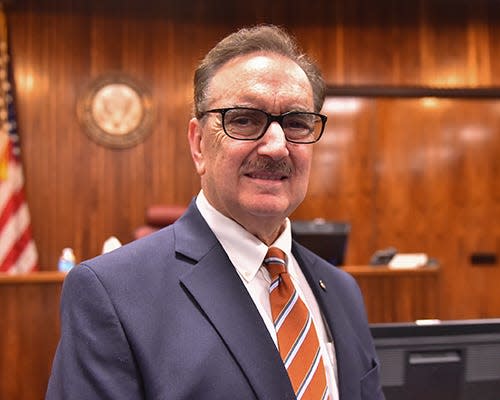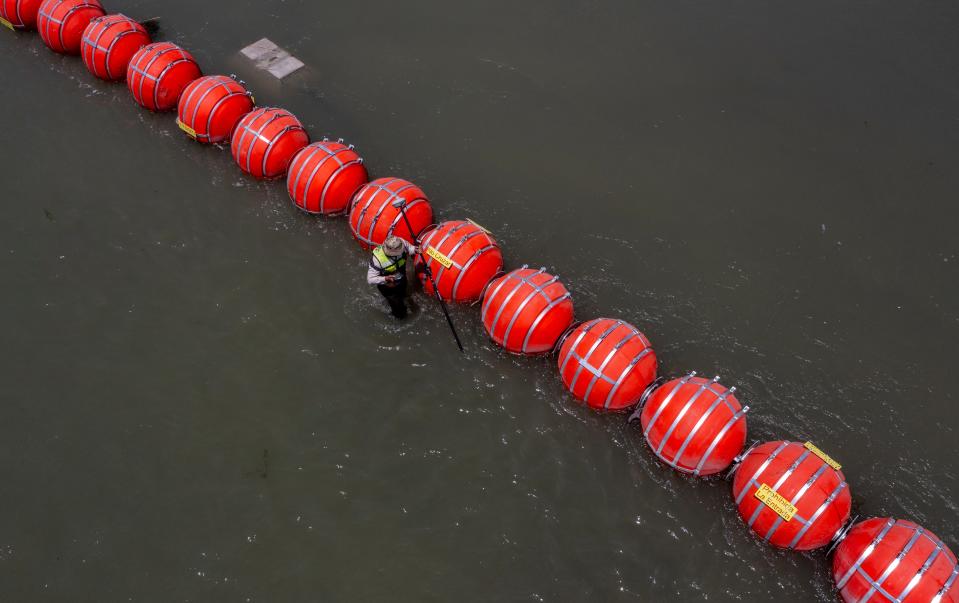Federal judge in lawsuit over buoys in Rio Grande says politics will not affect his rulings
- Oops!Something went wrong.Please try again later.
- Oops!Something went wrong.Please try again later.
Despite the red-hot political undertones in the U.S. Justice Department's lawsuit against Texas Gov. Greg Abbott over the buoy barrier installed in the Rio Grande, the federal judge presiding over the case made clear that any political considerations will get short shrift in his courtroom.
"This is a United States district court. It's not Congress. It's not the president," Senior U.S. Judge David Alan Ezra told the lawyers for both sides Tuesday during the first hearing in advance of a coming trial. "I am not here to engage in any type ... of political comment in this decision."
The decision before the 35-year veteran of the federal bench is whether the string of buoys floating as a border barrier in the international river near Eagle Pass should be removed pending the outcome of the case.
Testimony from three expert witnesses rested on whether Abbott needed approval from the U.S. Army Corps of Engineers before placing the 1,000 feet of giant orange balls that are tethered to 68 concrete blocks weighing 3,000 pounds apiece.
Abbott and lawyers for the state of Texas have insisted the governor acted under his legal authority to protect the state from an "invasion" caused by unlawful immigration and drug trafficking.
But the Justice Department, both in court documents and during witness questioning Tuesday, said that, under the Rivers and Harbors Act of 1899, the Corps of Engineers must sign off on structures placed in any navigable U.S. waters.
Patrick K. Sweeten, Abbott's general counsel, parried with Joseph Shelnutt of the Corps of Engineers over whether the section of the Rio Grande that flows between Eagle Pass and Piedras Negras, Coahuila, is actually navigable.
Sweeten showed a copy of a 1975 study describing the section as shallow and narrow and that no plans were in place to make it more hospitable to commercial boat traffic.
Shelnutt, a Corps of Engineers compliance and enforcement manager, insisted that the section still falls under the Corps' definition of a navigable waterway.

State Department witness: Buoys hampering U.S. relations with Mexico
A second witness for the Justice Department, Hillary Quam, who works as the U.S. State Department's coordinator with Mexico on border matters, said the buoys are hampering relations with the two countries.
Mexico's displeasure threatens to stall negotiations to update the two countries' water-sharing agreement and is complicating other matters in U.S. interests, Quam said. When Sweeten tried to steer the testimony toward the harm that unlawful immigration and drug trafficking were inflicting on binational relations, Ezra cut him off several times.
At one point, Sweeten asked Quam about Abbott's decision to help curtail illegal immigration and Ezra stepped in before the State Department official could answer.
"You are asking her to put herself in Gov. Abbott's mind," the judge said. "I don't think she can do that."
International agency says most buoys placed on Mexico’s side of river
The state's legal team also pushed back against the assertion by the International Boundary and Water Commission — a group established in 1899 and made up of representatives of both countries to oversee water agreements and other matters — that about 80% of the buoys had been placed on Mexico's side of the river.
Loren Flossman, a retired Border Patrol agent and a former director of the Border Patrol & Air and Marine Program Management Office who now works for the private company that manufactured the buoys, testified that the commission used dated maps to make its determination.
Flossman also contradicted Abbott's suggestion on Monday that the buoys had "drifted" toward Mexico after they had been installed. He said the concrete blocks directly below the buoys, plus dozens more designed keep the string from swaying, make the chain immovable.
That testimony came after Ezra expressed concern about the devices' location after he noticed that Abbott had said work crews with heavy equipment had gone back into the river to pull the floating barrier back toward the U.S. shoreline.
"I am concerned if something is moving around in the river," Ezra said.

Judge to determine whether buoys must be removed until legal battle ends
The judge gave the lawyers until Friday afternoon to submit final arguments in writing on whether the buoys must be pulled from the river until the lawsuit is settled. Ezra said he'd act as quickly as possible to make his ruling, which then would pave the way for the lawsuit to move forward.
To emphasize his judicial neutrality, the judge noted that although he was appointed to the bench by Republican President Ronald Reagan in 1988, a Democratic Senate confirmed him without controversy.
"There will be no leaning one way or the other in this court," Ezra said. "Somebody is going to be happy; somebody is going to be unhappy with my decision. That's a fact of life."
History of Abbott's buoy barrier
The buoys are part of Operation Lone Star, Abbott's controversial border protection program that started in March 2021. They are connected to form a barricade about 1,000 feet long and are fastened to the bottom of the river with nets underneath so people cannot swim under them. The 4-foot-wide orange buoys rotate to prevent people from climbing over.
The legal dispute includes accusations of Texas attempting to usurp federal control of national borders. Critics also say the buoys will make dangerous river crossings even more unsafe.
The buoys are installed in high-traffic areas where people are likely to attempt to cross the river.
The Texas governor is also coming under fire for erecting miles of razor wire on the banks of the Rio Grande to deter unauthorized crossings. Last month, USA TODAY documented how migrants, including many children, were ensnared and slashed by the wire, left with gashes in their heads and faces, lacerations, welts, and open wounds.
The sharp-edged barrier also restricts U.S. Border Patrol agents from accessing the river and helping migrants in distress.
“The State of Texas’s actions violate federal law, raise humanitarian concerns, present serious risks to public safety and the environment, and may interfere with the federal government’s ability to carry out its official duties,” the department previously wrote in a letter to the Texas governor, which was obtained by USA TODAY.
This article originally appeared on Austin American-Statesman: Texas border bouys lawsuit: Judge says there's no room for politics

